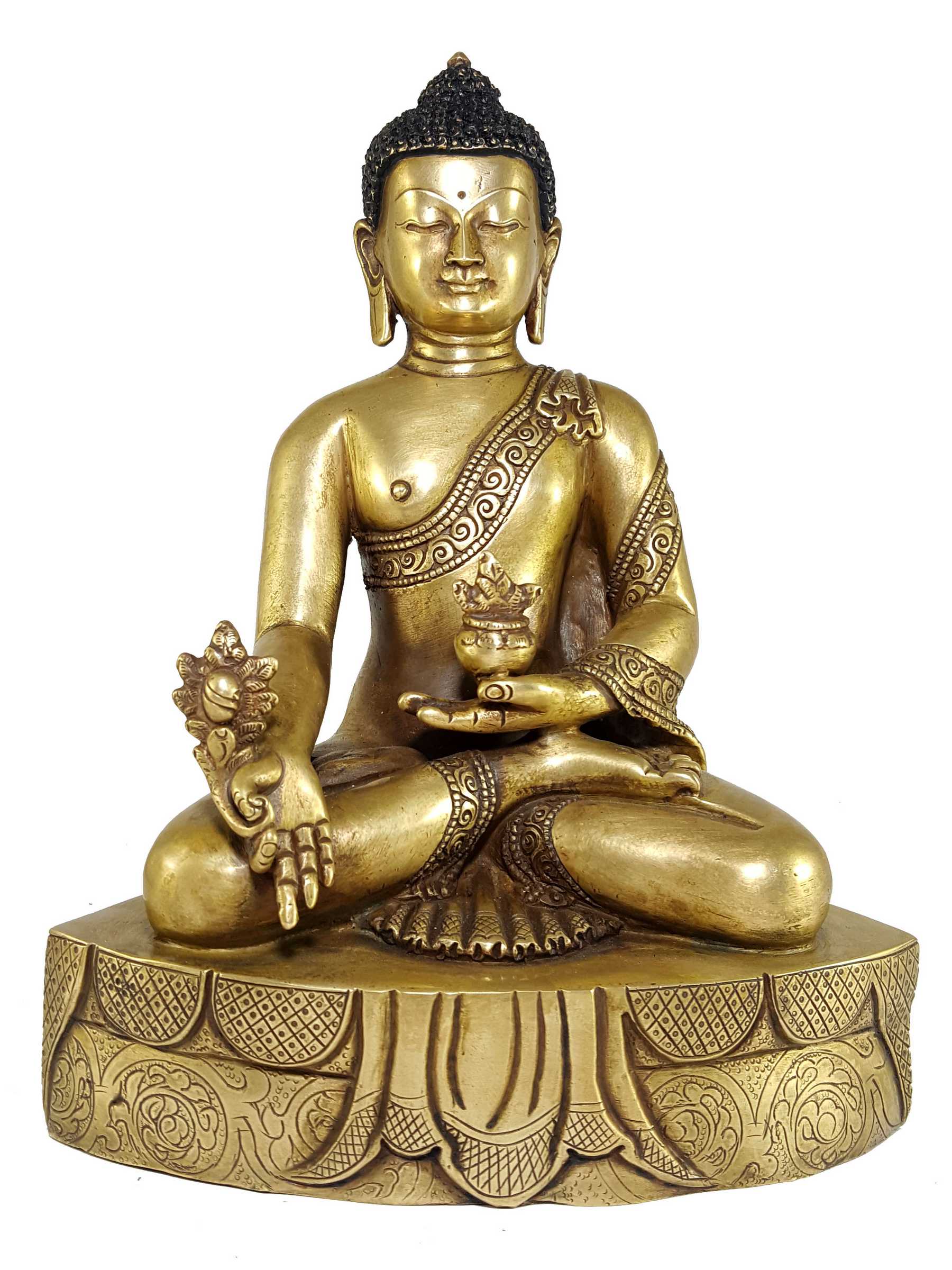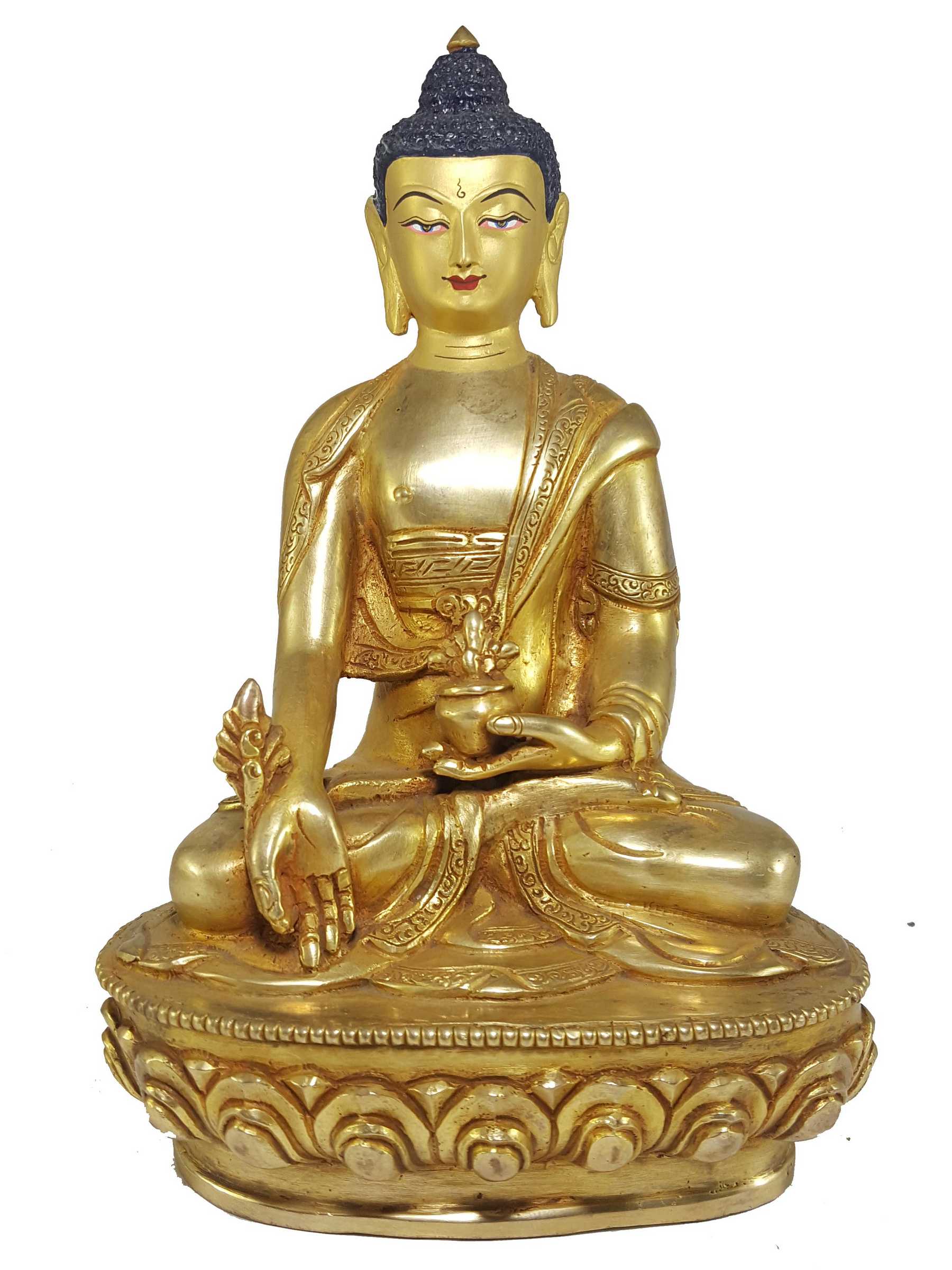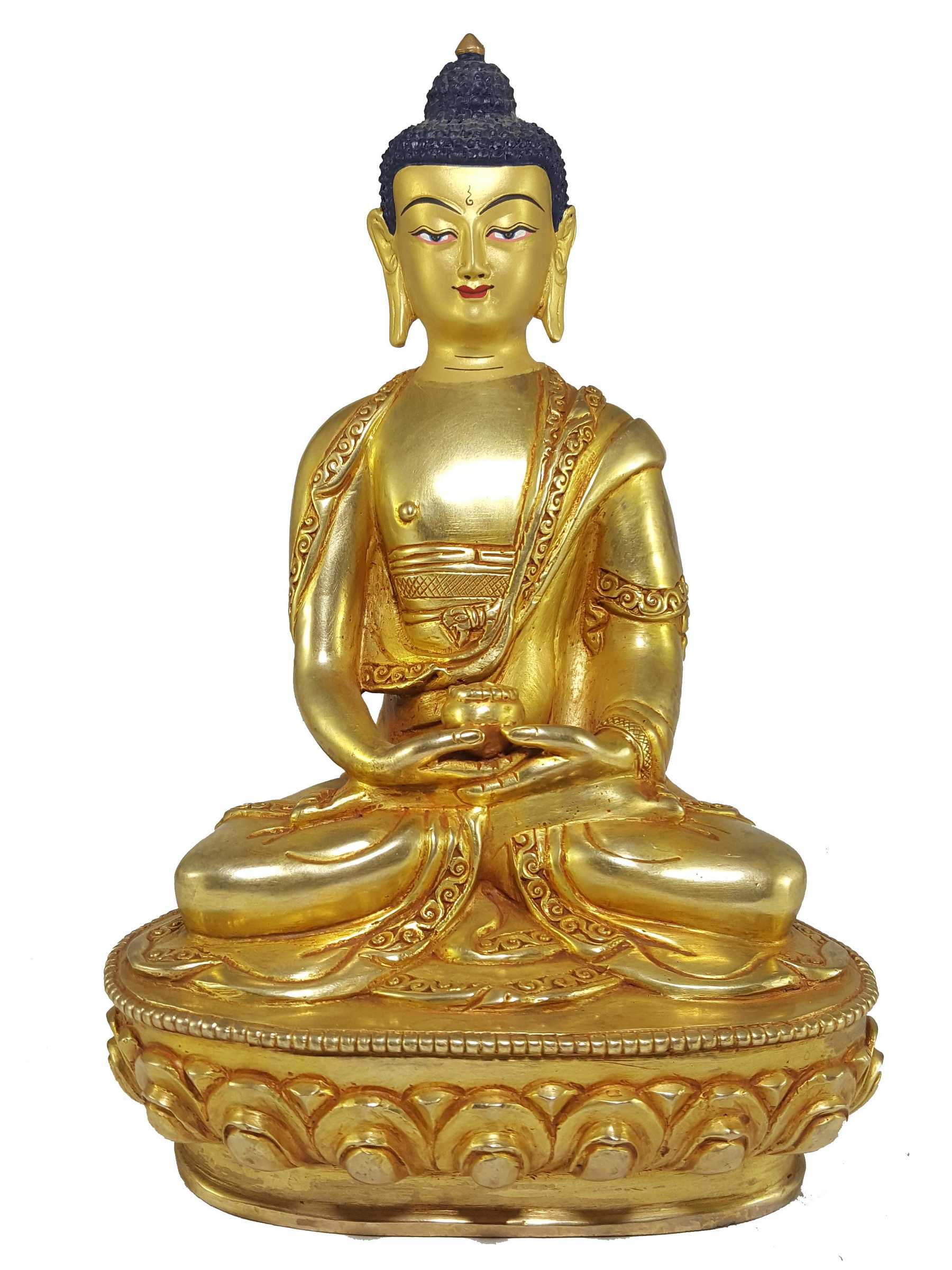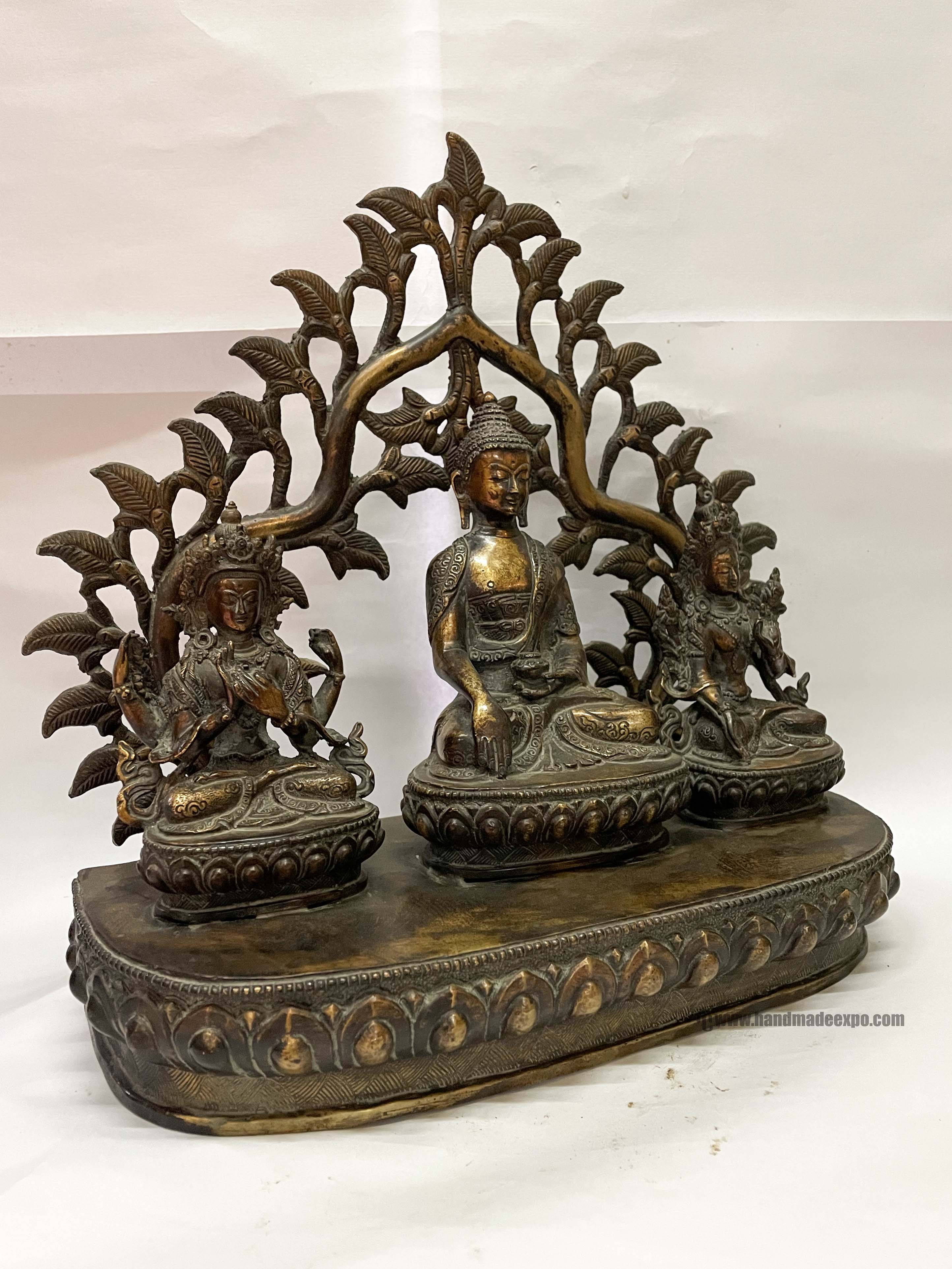Code
HCS24002
Weight
1.5 Kg / 3.31 lbs
Size
Height
10cm (4") Width
8cm (3") Depth
5cm (2") Material
Copper or Brass Select
Availability
Available
Date Added
2021-06-02 01:33:41
Note : We used to sell this product 4 years ago so it may no longer be in our stock.
It is possible that we still have it with our suppliers but the price could be different from before.
Feel free to order. We will verify availability and inform you promptly.
It is possible that we still have it with our suppliers but the price could be different from before.
Feel free to order. We will verify availability and inform you promptly.

Safe Payment
We accept Paypal, Money Transfer, Bank Transfer
Confidence
Protection covers your purchase and personal data.
Worldwide Delivery
We ship Worldwide, except Russia.Shipping cost US$25.2 for upto 0.5 kgs

Hotline
Talk to help line for your question on 9841267335Vajradhara : Description
Shakyamuni Buddha appeared in this world with the sole purpose of benefitting all sentient beings. Out of great compassion Lord Buddha revealed many different means/paths to enlightenment and set forth three Wheels of Law to suit varying degrees of intelligence and receptivities.
Shakyamuni Buddha himself was, it is said, in the form of Vajradhara while he was teaching tantric path to his gifted disciples.
Vajradhara is depicted holding a Vajra and a bell in his left hand and his arms are kept crossed in front of him expressing complete integration of Prajna and Upaya. He is usually depicted in blue colour in vajraparyanka posture. He has a crown, an Urna and an Ushnisha as a Sambhogakaya Buddha. Vajradhara is also depicted in father-mother (Anju-Aji in Newari) aspect. en he holds his usual symbols while his arms are crossed at the back of his consort. the consort is none other than Prajnaparamita in deified form.
The Kargyudpa lineage of Tibetan Buddhism begins with the Buddha Vajradhara. The individual in this tradition is allowed to visualize his root Guru as Buddha Vajradhara. Guru Tilopa is said to have received Mahamudra instruction directly from Buddha Vajradhara through visions and other extraordinary means.
In Nispannayogavali, Vajradhara is the main deity in Vajrasattvamandala. He is three faced, six-armed and reddish white in color. His right arm holds a vajra, a sword and a kapala and his left hand holds a bell, an ankush and a noose. He stands in the Ardhaparyanka posture and dances in Tandava style. Read More . . .
Shakyamuni Buddha appeared in this world with the sole purpose of benefitting all sentient beings. Out of great compassion Lord Buddha revealed many different means/paths to enlightenment and set forth three Wheels of Law to suit varying degrees of intelligence and receptivities.
Shakyamuni Buddha himself was, it is said, in the form of Vajradhara while he was teaching tantric path to his gifted disciples.
Vajradhara is depicted holding a Vajra and a bell in his left hand and his arms are kept crossed in front of him expressing complete integration of Prajna and Upaya. He is usually depicted in blue colour in vajraparyanka posture. He has a crown, an Urna and an Ushnisha as a Sambhogakaya Buddha. Vajradhara is also depicted in father-mother (Anju-Aji in Newari) aspect. en he holds his usual symbols while his arms are crossed at the back of his consort. the consort is none other than Prajnaparamita in deified form.
The Kargyudpa lineage of Tibetan Buddhism begins with the Buddha Vajradhara. The individual in this tradition is allowed to visualize his root Guru as Buddha Vajradhara. Guru Tilopa is said to have received Mahamudra instruction directly from Buddha Vajradhara through visions and other extraordinary means.
In Nispannayogavali, Vajradhara is the main deity in Vajrasattvamandala. He is three faced, six-armed and reddish white in color. His right arm holds a vajra, a sword and a kapala and his left hand holds a bell, an ankush and a noose. He stands in the Ardhaparyanka posture and dances in Tandava style. Read More . . .
Vajrasattva : Brief Introduction
Vajrasattva is also regarded as Adi-Buddha by Nepalese Bajracharya's who follow Vajrayana tradition according to the text Vajrasattva Kaya. His body is white with one face and two hands. His right-hand holds a five-pronged golden vajra at his heart. His left-hand holds a silver bell at his side. He sits in the Vajraparyanka posture wearing precious silks and ornaments with jewel diadem. His body is adorned with the major and minor marks of a Sambhogakaya and emits a clear limitless light. It appears to lack all notion of substantiality, like the reflection of the moon in the water.
Vajrasattva has a father-mother aspect too. Generally, this form is not exhibited in open. It is shown only to those who are initiated in the Highest Yoga Tantra. His form is the same as in the single one but his consort carries a Kartika in her right hand and a kapala in her left hand. Read More . . .
Vajrasattva is also regarded as Adi-Buddha by Nepalese Bajracharya's who follow Vajrayana tradition according to the text Vajrasattva Kaya. His body is white with one face and two hands. His right-hand holds a five-pronged golden vajra at his heart. His left-hand holds a silver bell at his side. He sits in the Vajraparyanka posture wearing precious silks and ornaments with jewel diadem. His body is adorned with the major and minor marks of a Sambhogakaya and emits a clear limitless light. It appears to lack all notion of substantiality, like the reflection of the moon in the water.
Vajrasattva has a father-mother aspect too. Generally, this form is not exhibited in open. It is shown only to those who are initiated in the Highest Yoga Tantra. His form is the same as in the single one but his consort carries a Kartika in her right hand and a kapala in her left hand. Read More . . .
Aparimita : Brief Introduction
Buddha Aparimita is very popular in bestowing long life upon the devotees. It is red in color. His two hands are in dhyana mudra and holds an ambrosia vase. He usually wears all the ornaments of different kinds peculiar to a Sambhogakaya Buddha. He is never depicted with any consort. He wears a crown and has Ushnisha and Urnakosh on his body. Read More . . .
Buddha Aparimita is very popular in bestowing long life upon the devotees. It is red in color. His two hands are in dhyana mudra and holds an ambrosia vase. He usually wears all the ornaments of different kinds peculiar to a Sambhogakaya Buddha. He is never depicted with any consort. He wears a crown and has Ushnisha and Urnakosh on his body. Read More . . .
Chenrezig : Brief Introduction
Of all the deities in Mahayana Buddhism, the bodhisattva Avalokiteshvara, Chenrezig, is one of the most celebrated. He is the lord gifted with complete enlightenment, who refrains from entering the blissful state of nirvana to remain here below and save the living being of the earth. This devotion to the salvation of others emphasizes profound compassion.
Compassion for others had always been regarded as a virtue in early Buddhism, but it had a somewhat subordinate place to wisdom. In Mahayana Buddhism, compassion received an equal emphasis with wisdom, perhaps because the Mahayana was more consciously universal and covered a wider sector of society. In this view of the world, all men and women, not just those leading a monastic life, could achieve nirvana. Read More . . .
Of all the deities in Mahayana Buddhism, the bodhisattva Avalokiteshvara, Chenrezig, is one of the most celebrated. He is the lord gifted with complete enlightenment, who refrains from entering the blissful state of nirvana to remain here below and save the living being of the earth. This devotion to the salvation of others emphasizes profound compassion.
Compassion for others had always been regarded as a virtue in early Buddhism, but it had a somewhat subordinate place to wisdom. In Mahayana Buddhism, compassion received an equal emphasis with wisdom, perhaps because the Mahayana was more consciously universal and covered a wider sector of society. In this view of the world, all men and women, not just those leading a monastic life, could achieve nirvana. Read More . . .
Ceramic Molding System
The Buddhist Statue Of Various Bodhisattva With Consort, [glossy], [free Patina Finishing], [choice Of Material] has been crafted using the Ceramic mold casting process, a modern approach that provides an alternative to traditional methods such as the lost-wax system or rubber molding. Also referred to as ceramic molding, this technique involves the creation of a ceramic mold to cast the statue. The process begins by making a precise and detailed wax model of the desired sculpture. The wax model is then coated with layers of ceramic material, creating a sturdy mold. Once the mold is complete, it is fired in a kiln, causing the wax to melt and escape, leaving behind a cavity that perfectly replicates the original sculpture. Molten metal is then poured into the mold, allowing it to fill the cavity and take on the desired form. Once cooled and solidified, the ceramic mold is carefully broken away, revealing the final metal statue. Read More . . .
The Buddhist Statue Of Various Bodhisattva With Consort, [glossy], [free Patina Finishing], [choice Of Material] has been crafted using the Ceramic mold casting process, a modern approach that provides an alternative to traditional methods such as the lost-wax system or rubber molding. Also referred to as ceramic molding, this technique involves the creation of a ceramic mold to cast the statue. The process begins by making a precise and detailed wax model of the desired sculpture. The wax model is then coated with layers of ceramic material, creating a sturdy mold. Once the mold is complete, it is fired in a kiln, causing the wax to melt and escape, leaving behind a cavity that perfectly replicates the original sculpture. Molten metal is then poured into the mold, allowing it to fill the cavity and take on the desired form. Once cooled and solidified, the ceramic mold is carefully broken away, revealing the final metal statue. Read More . . .
Introduction :
Shakti Yab-yum is a common symbol in Nepalese and Tibetan art. It represents the primordial union of wisdom and compassion, depicted as a male deity in union with his female consort via the similar concept of interpenetration or "coalescence," as illustrated by the concept of Indra's net. The male figure represents compassion and dexterity, while the female figure represents insight. The female is seated on the male's lap in yab-yum. A rare rendition of a similar figure, but reversed, with the male sitting on the female's lap, is known as yum-yab.
Yab-yum is widely regarded as representing the primordial union of wisdom and compassion. The masculine form is active in Buddhism, representing the compassion and skillful means that must be developed in order to achieve enlightenment. The feminine form is passive and represents wisdom, both of which are required for enlightenment. The figures, when joined, represent the union required to remove the veils of Maya, the false duality of object and subject.
These figures are frequently worked into statues or reliefs, or they are painted on thangkas. Yab-yum can also be represented by the aniconic symbols yantra and mandala.
In Tibetan Buddhism :These figures are frequently worked into statues or reliefs, or they are painted on thangkas. Yab-yum can also be represented by the aniconic symbols yantra and mandala.
In Tibetan Buddhism, the same ideas are to be found concerning the bell and the dorje, which, like the yab-yum, symbolize the dualism that must be transcended. The sacred Tantric practice leads to rapid development of mind by using the experience of bliss, non-duality, and ecstasy while in communion with one's consort, either visualized, or in the case of advanced practitioners, in some cases physical. In one important Anuttarayoga text, where Tilopa expounds the meaning to Naropa, it is said:
When you rely on a consort, the wisdom of empty bliss will arise, so enter into unionâthe blessing of method and wisdom. Bring it down slowly, retain it, reverse it, and draw it back up. Bring it to the places in the body and let it spread throughout. When you remain free of desire, the wisdom of empty bliss will appear.
Indicating the advanced nature of the actual practice with consort, the verses are the last in what is already widely considered as a text for the most advanced practitioners, a fact clearly evident in the story about Naropa's receiving the teaching.
Hindiusm :When you rely on a consort, the wisdom of empty bliss will arise, so enter into unionâthe blessing of method and wisdom. Bring it down slowly, retain it, reverse it, and draw it back up. Bring it to the places in the body and let it spread throughout. When you remain free of desire, the wisdom of empty bliss will appear.
Indicating the advanced nature of the actual practice with consort, the verses are the last in what is already widely considered as a text for the most advanced practitioners, a fact clearly evident in the story about Naropa's receiving the teaching.
In Hinduism the yab-yum has a slightly different meaning. There, the embraced posture represents the divine strength of creation. The Hindu concept is of a passive masculine deity embracing his spouse, called shakti, which represents his activity or power. The yab-yum of Chakrasamvara-Vajravarahi is directly influenced from the Hinduist depiction of Kali and Bhairava in union.
Sadhan :The symbolism of union and sexual polarity is a central teaching in Tantric Buddhism, especially in Tibet. The union is realised by the practitioner as a mystical experience within one's own body.
As a tantric practice, Yab-yum is akin to the Karmamudr? or "actionseal". This is the tantric yoga involving a physical partner. However, the aim of the practice is to control one's winds. This sadhana is part of the completion stage.


![Buddhist Statue Of Various Bodhisattva With Consort, [glossy], [free Patina Finishing], [choice Of Material]](https://handicraftseller.com/uploads/pics/product/thumb/2021/06/24002_0.jpg)
![Buddhist Statue Of Various Bodhisattva With Consort, [glossy], [free Patina Finishing], [choice Of Material]](https://handicraftseller.com/uploads/pics/product/thumb/2021/06/24002_1.jpg)
![Buddhist Statue Of Various Bodhisattva With Consort, [glossy], [free Patina Finishing], [choice Of Material]](https://handicraftseller.com/uploads/pics/product/thumb/2021/06/24002_2.jpg)
![Buddhist Statue Of Various Bodhisattva With Consort, [glossy], [free Patina Finishing], [choice Of Material]](https://handicraftseller.com/uploads/pics/product/thumb/2021/06/24002_3.jpg)
![Buddhist Statue Of Various Bodhisattva With Consort, [glossy], [free Patina Finishing], [choice Of Material]](https://handicraftseller.com/uploads/pics/product/thumb/2021/06/24002_4.jpg)
![Buddhist Statue Of Various Bodhisattva With Consort, [glossy], [free Patina Finishing], [choice Of Material]](https://handicraftseller.com/uploads/pics/product/thumb/2021/06/24002.jpg)

 of Shakyamuni Buddha, Amitabha Buddha
of Shakyamuni Buddha, Amitabha Buddha  of Shakyamuni Buddha, Amitabha Buddha
of Shakyamuni Buddha, Amitabha Buddha  of Shakyamuni Buddha, Amitabha Buddha
of Shakyamuni Buddha, Amitabha Buddha  of Shakyamuni Buddha, Amitabha Buddha
of Shakyamuni Buddha, Amitabha Buddha  of Pancha Buddha,five Dhyani Buddha Set
of Pancha Buddha,five Dhyani Buddha Set  of Pancha Buddha,five Dhyani Buddha Set
of Pancha Buddha,five Dhyani Buddha Set  of Shakyamuni Buddha, Amitabha Buddha
of Shakyamuni Buddha, Amitabha Buddha  of Shakyamuni Buddha, Amitabha Buddha
of Shakyamuni Buddha, Amitabha Buddha  and Gold Edition Shakyamuni, Vajrasattva, Chenrezig, Padmasambhava, Jambhala Etc" title="15 Essential Buddhist Gods In Miniature: Copper
and Gold Edition Shakyamuni, Vajrasattva, Chenrezig, Padmasambhava, Jambhala Etc" title="15 Essential Buddhist Gods In Miniature: Copper  and Gold Edition Shakyamuni, Vajrasattva, Chenrezig, Padmasambhava, Jambhala Etc" title="15 Essential Buddhist Gods In Miniature: Copper
and Gold Edition Shakyamuni, Vajrasattva, Chenrezig, Padmasambhava, Jambhala Etc" title="15 Essential Buddhist Gods In Miniature: Copper  of Three Buddha Set,
of Three Buddha Set,  of Three Buddha Set,
of Three Buddha Set,  Dorje Drolo Set, Buddhist Handmade Statue,
Dorje Drolo Set, Buddhist Handmade Statue,  Dorje Drolo Set, Buddhist Handmade Statue,
Dorje Drolo Set, Buddhist Handmade Statue,  Sakyapa Set, Buddhist Handmade Statue,
Sakyapa Set, Buddhist Handmade Statue,  Sakyapa Set, Buddhist Handmade Statue,
Sakyapa Set, Buddhist Handmade Statue,  of 21 Tara Set
of 21 Tara Set  of 21 Tara Set
of 21 Tara Set  of Buddhist Statue
of Buddhist Statue  of Buddhist Statue
of Buddhist Statue